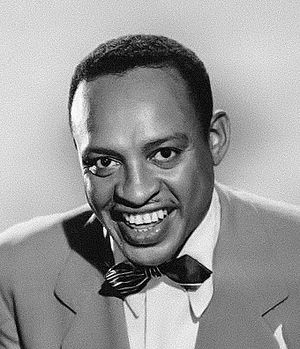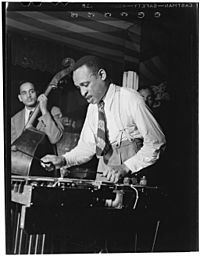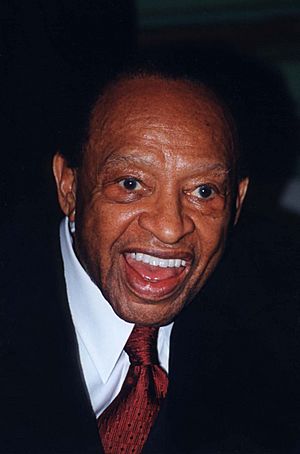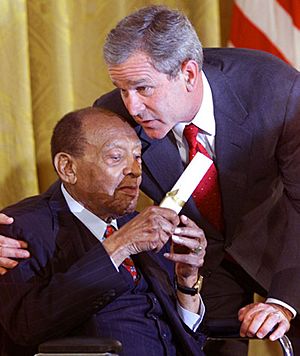Lionel Hampton facts for kids
Quick facts for kids
Lionel Hampton
|
|
|---|---|
 |
|
| Background information | |
| Birth name | Lionel Leo Hampton |
| Born | April 20, 1908 Louisville, Kentucky, U.S. |
| Died | August 31, 2002 (aged 94) New York City, U.S. |
| Genres | |
| Occupation(s) |
|
| Instruments |
|
| Years active | 1927–2002 |
| Labels | Decca |
| Associated acts | |
Lionel Leo Hampton (born April 20, 1908 – died August 31, 2002) was an American jazz musician. He was famous for playing the vibraphone, piano, and other percussion instruments. He also led his own bands.
Hampton worked with many famous jazz musicians. These included Teddy Wilson, Benny Goodman, Louis Armstrong, and Quincy Jones. In 1992, he was honored in the Alabama Jazz Hall of Fame. He also received the National Medal of Arts in 1996 for his contributions to music.
Contents
Biography
Early life and musical start
Lionel Hampton was born in Louisville, Kentucky, in 1908. His mother raised him. They moved to Birmingham, Alabama, and then to Chicago, Illinois, in 1916. As a young boy, Lionel joined the Bud Billiken Club. This was like the Boy Scouts, but for African American youth, as other groups were not open to them at the time.
In the 1920s, when he was a teenager, Lionel learned to play the xylophone and drums. He was raised Catholic and first played the fife and drum at a school near Chicago.
Beginning his career
Lionel Hampton started his music career playing drums for a band in Chicago. He later moved to California around 1927. There, he played drums for different bands, including the Les Hite band. He was known for his cool drum tricks, like twirling sticks without missing a beat!
While with the Les Hite band, he started practicing the vibraphone. This instrument is like a xylophone but with metal bars and a special motor that makes the sound vibrate. In 1930, jazz legend Louis Armstrong heard Lionel play the vibraphone. Armstrong was so impressed that he asked Lionel to play it with him. This is how Lionel Hampton became famous for playing the vibraphone, helping to make it a popular instrument in jazz.
Lionel also studied music at the University of Southern California. In 1934, he led his own band. He even appeared in a movie called Pennies From Heaven in 1936, playing drums alongside Louis Armstrong.
Playing with Benny Goodman
In 1936, the Benny Goodman Orchestra came to Los Angeles. Benny Goodman invited Lionel Hampton to join his group. This group became the Benny Goodman Quartet. It included pianist Teddy Wilson and drummer Gene Krupa. This quartet was one of the first jazz groups to have both Black and white musicians playing together for audiences. They were a very popular small group at the time.
Lionel played with Benny Goodman for almost four years. He became very well-known in the swing music world. He added exciting and new sounds to Goodman's group. He even played at Goodman's famous concert at Carnegie Hall in 1938. During this time, Lionel also recorded many great songs with his own all-star groups.
Leading his own orchestra
In 1940, Lionel Hampton left Benny Goodman's group to start his own big band. This band became very famous in the 1940s and early 1950s.
One of their most famous songs was "Flying Home". The version recorded in 1942 became a huge hit. It featured an amazing solo by Illinois Jacquet. This song became a theme song for Lionel Hampton and other musicians.
Lionel Hampton's band often played at the "Cavalcade of Jazz" concerts in Los Angeles. These were big outdoor shows. At one concert in 1950, Lionel and his band played "Flying High" while marching around the field. The crowd of 14,000 people got so excited that they threw things in the air and rushed onto the field! Many other famous musicians also played at these concerts.
From the mid-1940s to the early 1950s, Lionel led a lively rhythm & blues band. Many young musicians who later became famous played in his band. These included bassist Charles Mingus, saxophonist Johnny Griffin, guitarist Wes Montgomery, and singer Dinah Washington.
In 1953, Hampton's orchestra toured Europe. This tour included future jazz stars like Clifford Brown and Quincy Jones. Lionel also recorded with other famous musicians like Oscar Peterson and Stan Getz. In 1968, he performed with Louis Armstrong in Italy and even received a special medal from Pope Paul VI.
Later years and legacy
In the 1960s and 1970s, Lionel Hampton continued to perform. He also started his own record label called Who's Who in Jazz in 1977.
Starting in 1984, Lionel and his band played at the University of Idaho's annual jazz festival. The festival was later renamed the Lionel Hampton Jazz Festival in his honor. In 1987, the university's music school was also named after him. This was the first university music school named after a jazz musician!
Lionel Hampton stayed active until 1991, when he had a stroke. This, along with arthritis, made it harder for him to perform. However, he still played at the Smithsonian National Museum of American History in 2001, shortly before he passed away.
Lionel Hampton died in New York City on August 31, 2002, at the age of 94. He was buried in Woodlawn Cemetery. His funeral included a performance by Wynton Marsalis.
Personal life
Lionel Hampton married Gladys Riddle in 1936. Gladys was very important to his career because she managed his business affairs. Many musicians said that Lionel handled the music, and Gladys handled the business side of things. Gladys passed away in 1971.
Lionel also had an interest in Judaism in the 1950s and helped raise money for Israel. Later in life, he became a Christian Scientist. He was also a high-ranking member of the Prince Hall freemasons, a fraternal organization.
In 1997, his apartment caught fire, and he lost many of his awards and belongings. Luckily, Lionel was not hurt.
Charity and public service
Lionel Hampton was very involved in building public housing projects. He started the Lionel Hampton Development Corporation. They built the Lionel Hampton Houses in Harlem, New York, in the 1960s. His wife, Gladys, also had a housing project named after her. In the 1980s, Lionel built another housing project called Hampton Hills in Newark, New Jersey.
Lionel Hampton was a strong supporter of the Republican Party, one of the two major political parties in the United States. He attended several Republican National Conventions. He also served on the New York City Human Rights Commission. He even helped with Gerald Ford's re-election campaign in 1976. Over his lifetime, he gave a lot of money to Republican campaigns. However, in 1996, he supported Bill Clinton, saying the Republican party no longer represented his views.
Awards and honors
Lionel Hampton received many awards and honors throughout his life for his amazing contributions to music:
- 2021 – Grammy Lifetime Achievement Award (given after his death)
- 2001 – Harlem Jazz and Music Festival's Legend Award
- 1996 – International Jazz Hall of Fame Induction and Award
- 1996 – National Medal of Arts presented by President Bill Clinton
- 1995 – Honorary Commissioner of Civil Rights
- 1995 – Honorary Doctorate from the New England Conservatory of Music
- 1993 – Honorary Doctorate from the University of Maryland Eastern Shore
- 1992 – Inducted into the Alabama Jazz Hall of Fame
- 1992 – "Contributions To The Cultural Life of the Nation" award from John F. Kennedy Center for the Performing Arts
- 1988 – The National Endowment for the Arts Jazz Masters Fellowship
- 1988 – The National Association of Jazz Educators Hall of Fame Award
- 1987 – Honorary Doctorate of Humanities from the University of Idaho (UI's School of Music renamed "Lionel Hampton School of Music")
- 1987 – The Roy Wilkins Memorial Award from the NAACP
- 1986 – The "One of a Kind" Award from Broadcast Music, Inc.
- 1984 – Jazz Hall of Fame Award from the Institute of Jazz Studies
- 1984 – Honorary Doctorate of Music from USC
- 1983 – The International Film and Television Festival of New York City Award
- 1983 – Honorary Doctorate of Humane Letters from the State University of New York
- 1982 – Hollywood Walk of Fame Star
- 1981 – Honorary Doctorate of Humanities from Glassboro State College
- 1979 – Honorary Doctorate of Music from Howard University
- 1978 – Bronze Medallion from New York City
- 1976 – Honorary Doctorate of Humanities from Daniel Hale Williams University
- 1975 – Honorary Doctorate of Music from Xavier University of Louisiana
- 1974 – Honorary Doctorate of Fine Arts from Pepperdine University
- 1968 – Papal Medal from Pope Paul VI
- 1966 – Handel Medallion
- 1957 – American Goodwill Ambassador by President Dwight D. Eisenhower
- 1954 – Israel's Statehood Award
Filmography
Hampton appeared as himself in these movies:
| Year | Movie | Director | Genre |
|---|---|---|---|
| 1933 | Girl Without A Room | Ralph Murphy | Comedy |
| 1936 | Pennies From Heaven | Norman Z. McLeod | Comedy/Musical |
| 1937 | Hollywood Hotel | Busby Berkeley | Musical/Romance |
| 1938 | For Auld Lang Syne | ? | Documentary |
| 1948 | A Song Is Born | Howard Hawks | Comedy/Musical |
| 1949 | Lionel Hampton and His Orchestra | Will Cowan | Music |
| 1955 | Music, Music and Only Music | Ernst Matray | Comedy |
| 1955 | The Benny Goodman Story | Valentine Davies | Drama |
| 1957 | Mister Rock and Roll | Charles S. Dubin | Drama/Musical |
| 1978 | No Maps on My Taps | George T. Nierenberg | Documentary |
| 1980 | But Then She's Betty Carter | Michelle Parkerson | Documentary |
See also
 In Spanish: Lionel Hampton para niños
In Spanish: Lionel Hampton para niños





